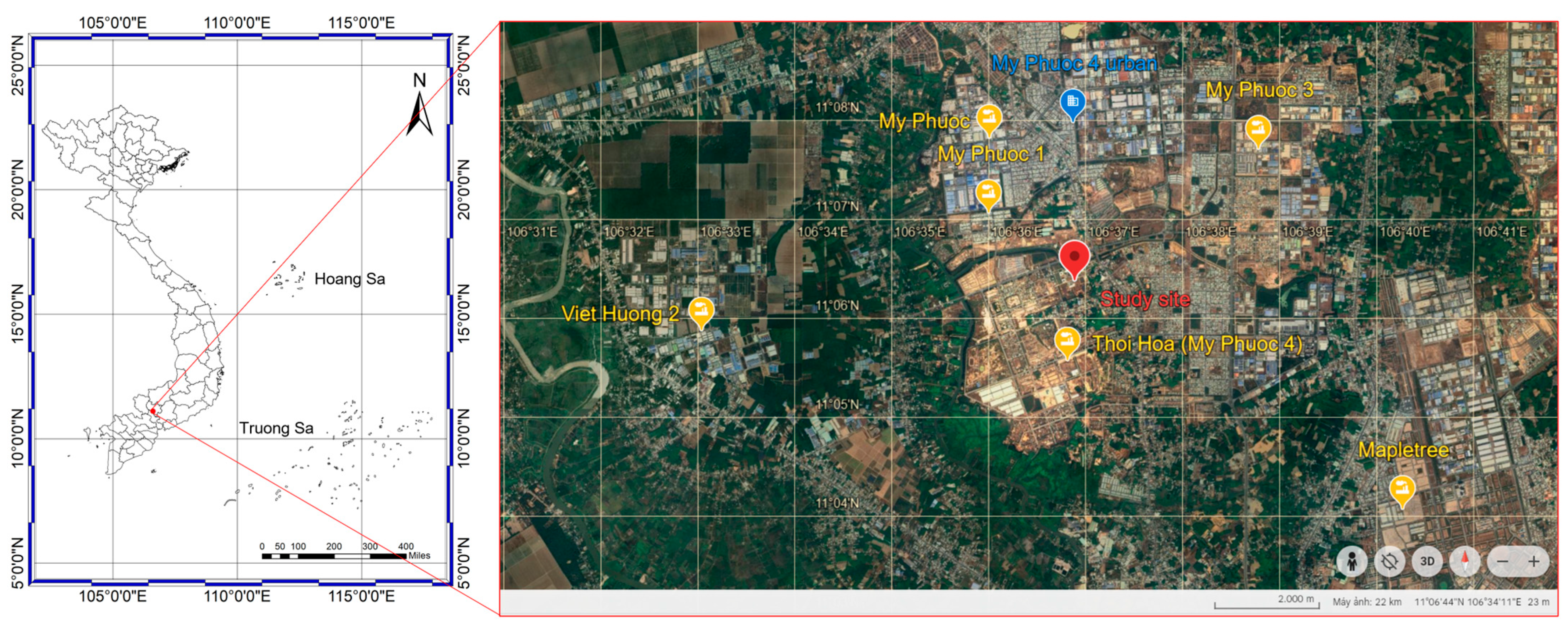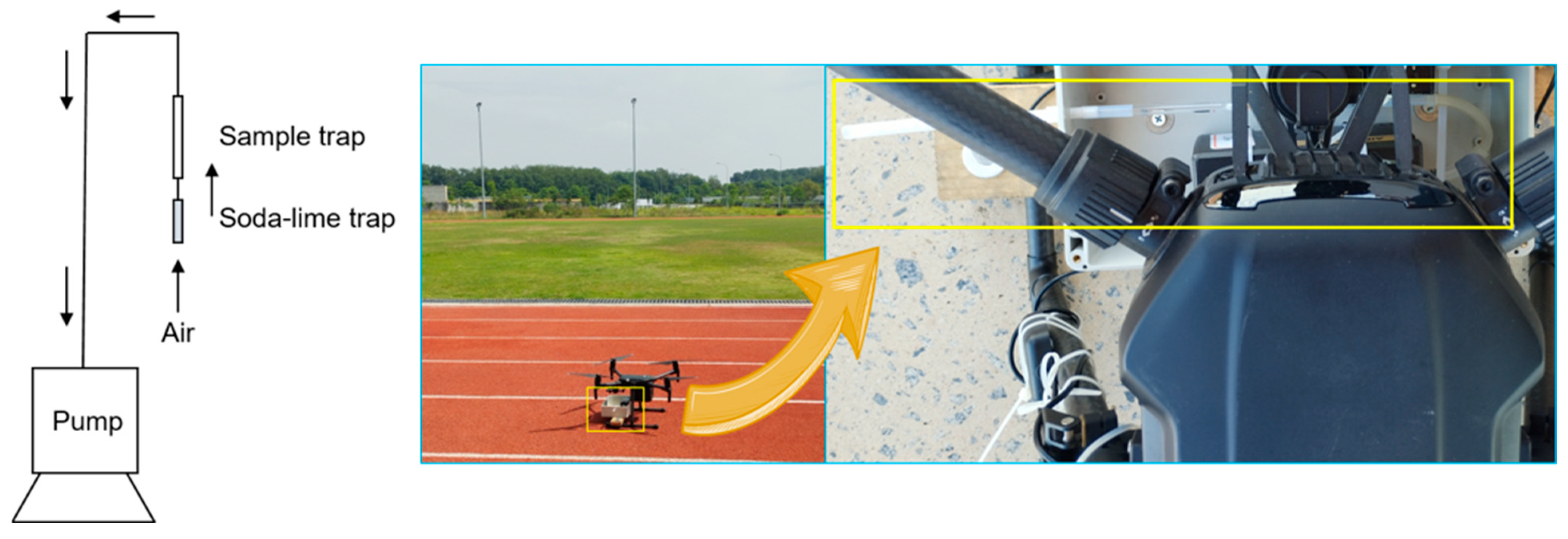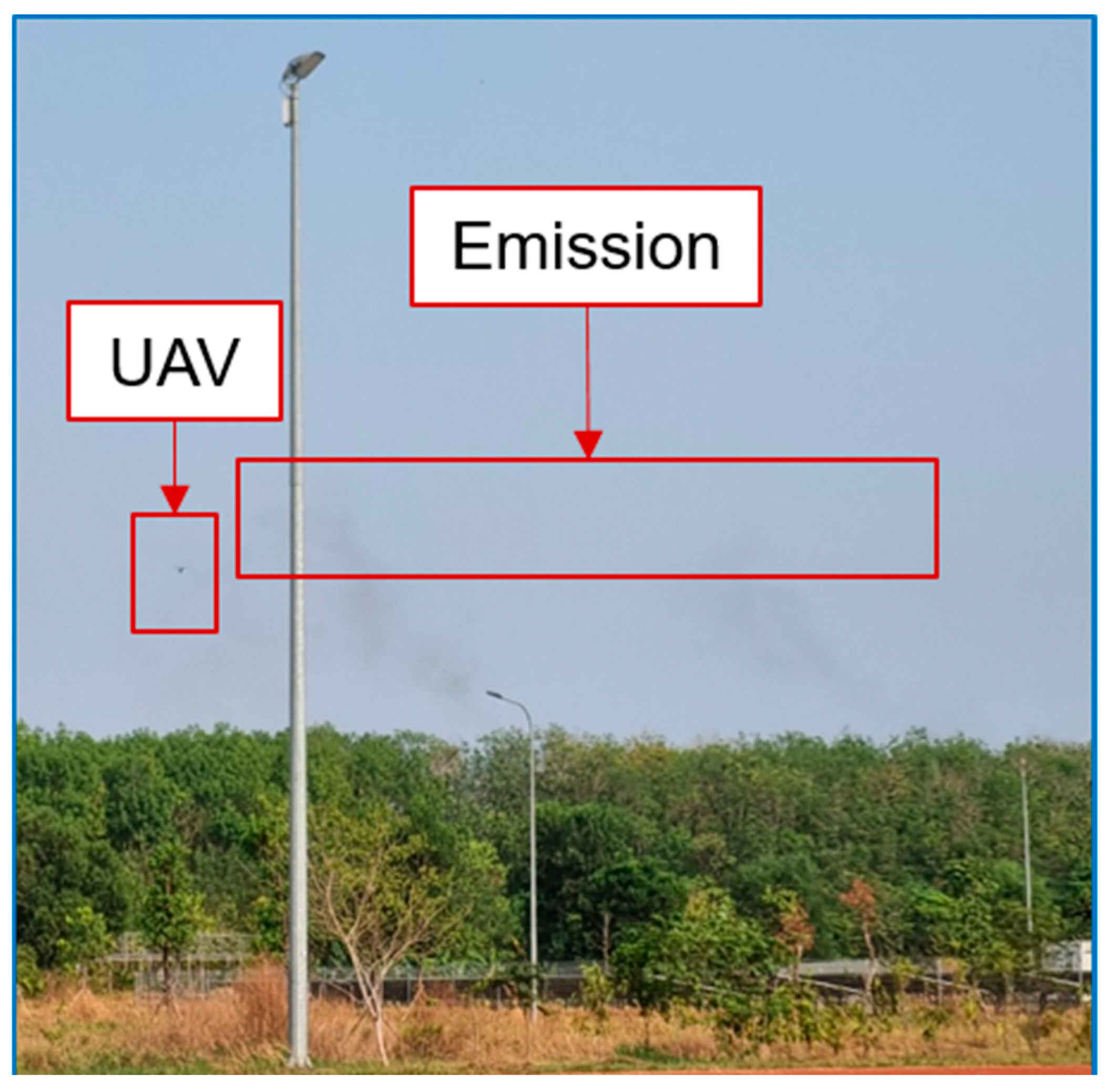Revealing Vertical Distribution of Atmospheric Mercury Using Drone-Based Monitoring Technique: A Case Study in Vietnam
Abstract
1. Introduction
2. Materials and Methods
2.1. Research Location
2.2. TGM Sampling Using UAV
2.3. Hg Analysis
3. Results and Discussion
3.1. TGM Data
3.2. Distribution of TGM Concentrations Under Normal and Emission Conditions
3.3. TGM Concentrations by Altitude
4. Conclusions and Implications
Author Contributions
Funding
Institutional Review Board Statement
Informed Consent Statement
Data Availability Statement
Conflicts of Interest
References
- Fu, X.; Liu, C.; Zhang, H.; Xu, Y.; Li, J.; Lyu, X.; Zhang, G.; Guo, H.; Wang, X.; Zhang, L.; et al. Isotopic compositions of atmospheric total gaseous mercury in 10 Chinese cities and implications for land surface emissions. Atmos. Meas. Tech. 2021, 21, 6721–6734. [Google Scholar] [CrossRef]
- Hien, T.T.; Nguyen, L.S.P.; Truong, M.T.; Pham, T.D.H.; Ngan, T.A.; Minh, T.H.; Hau, L.Q.; Trung, H.T.; Nhon, N.T.T.; Nguyen, N.T. Spatiotemporal variations of atmospheric mercury at urban and suburban areas in Southern Vietnam megacity: A preliminary year-round measurement study. Atmos. Environ. 2024, 333, 120664. [Google Scholar] [CrossRef]
- Nguyen, L.S.P.; Pham, T.D.H.; To, T.H.; Tran, A.N.; Tran, V.K.; Nguyen, T.N. Influence of Residential Combustion on Total Gaseous Mercury (TGM) Levels: A Preliminary Study at an Urban Megacity in Vietnam. J. Tech. Educ. Sci. 2023, 18, 1–9. [Google Scholar] [CrossRef]
- UNEP. Global Mercury Assessment 2013: Sources, Emissions, Releases and Environmental Transport; UNEP Chemicals Branch: Geneva, Switzerland, 2013; Volume 42. [Google Scholar]
- Obrist, D.; Kirk, J.L.; Zhang, L.; Sunderland, E.M.; Jiskra, M.; Selin, N.E. A review of global environmental Hg processes in response to human and natural perturbations: Changes of emissions, climate, and land use. Ambio 2018, 47, 116–140. [Google Scholar] [CrossRef]
- UN Environment. Global Mercury Assessment 2018. UN Environment Programme; Chemicals and Health Branch: Geneva, Switzerland, 2019. [Google Scholar]
- Wu, Q.; Wang, S.; Li, G.; Liang, S.; Lin, C.-J.; Wang, Y.; Cai, S.; Liu, K.; Hao, J. Temporal Trend and Spatial Distribution of Speciated Atmospheric Mercury Emissions in China During 1978–2014. Environ. Sci. Technol. 2016, 50, 13428–13435. [Google Scholar] [CrossRef]
- Wang, J.-L.; Chen, Y.-C.; Chen, W.-N.; Wang, S.-H.; Chuang, M.-T.; Lin, N.-H.; Chou, C.C.-K.; Huang, W.-S.; Ke, L.-J.; Pan, X.-X.; et al. Spatiotemporal characterization of PM2.5, O3, and trace gases associated with East Asian continental outflows via drone sounding. Sci. Total. Environ. 2024, 930, 172732. [Google Scholar]
- Nguyen, L.S.P.; Hien, T.T. Long-Range Atmospheric Mercury Transport from Across East Asia to a Suburban Coastal Area in Southern Vietnam. Bull. Environ. Contam. Toxicology 2024, 112, 14. [Google Scholar] [CrossRef]
- Siddiqi, Z.M. Transport and fate of mercury (Hg) in the environment: Need for continuous monitoring. In Handbook of Environmental Materials Management; Springer: Berlin/Heidelberg, Germany, 2018; pp. 1–20. [Google Scholar]
- Inoue, J.; Seko, H.; Sato, K.; Sakai, T. Operational capability of drone-based meteorological profiling in an urban area. J. Geophys. Res. Atmos. 2025, 130, e2024JD041927. [Google Scholar] [CrossRef]
- Li, C.; He, H.-D.; Peng, Z.-R. Spatial distributions of particulate matter in neighborhoods along the highway using unmanned aerial vehicle in Shanghai. Build. Environ. 2022, 211, 108754. [Google Scholar] [CrossRef]
- Suo, Z.; Wang, Q.; Lu, Y.; Yao, Y.; Song, Q.; Ding, J.; Ju, W.; Zhang, Z. Satellite-borne identification and quantification of wildfire smoke emissions in North America via a novel UV-based index. Atmos. Environ. 2025, 346, 121069. [Google Scholar] [CrossRef]
- Salgado, L.; López-Sánchez, C.; Colina, A.; Baragaño, D.; Forján, R.; Gallego, J. Hg and As pollution in the soil-plant system evaluated by combining multispectral UAV-RS, geochemical survey and machine learning. Environ. Pollut. 2023, 333, 122066. [Google Scholar] [CrossRef] [PubMed]
- Cabassi, J.; Lazzaroni, M.; Giannini, L.; Mariottini, D.; Nisi, B.; Rappuoli, D.; Vaselli, O. Continuous and near real-time measurements of gaseous elemental mercury (GEM) from an Unmanned Aerial Vehicle: A new approach to investigate the 3D distribution of GEM in the lower atmosphere. Chemosphere 2022, 288, 132547. [Google Scholar] [CrossRef] [PubMed]
- Nguyen, L.S.P.; Pham, T.D.H.; Tran, A.N.; Hien, T.T. Investigating and optimizing a method to determine atmospheric mercury for application in Ho Chi Minh City, Vietnam. Sci. Tech. Dev. J. Nat. Sci. 2023, 7, 2552–2560. [Google Scholar]
- Nguyen, L.S.P.; Hau, L.Q.; Pham, T.D.H.; Thuy, N.T.; Hien, T.T. Concurrent measurements of atmospheric Hg in outdoor and indoor at a megacity in Southeast Asia: First insights from the region. Atmos. Pollut. Res. 2024, 15, 102326. [Google Scholar] [CrossRef]
- Fadhila, M.J.; Gharghanb, S.K.; Saeeda, T.R. LoRa sensor node mounted on drone for monitoring industrial area gas pollution. Eng. Technol. J. 2024, 42, 248–260. [Google Scholar] [CrossRef]
- Zhao, T.; Yang, D.; Liu, Y.; Cai, Z.; Yao, L.; Che, K.; Ren, X.; Bi, Y.; Yi, Y.; Wang, J.; et al. Development of an Integrated Lightweight Multi-Rotor UAV Payload for Atmospheric Carbon Dioxide Mole Fraction Measurements. Atmosphere 2022, 13, 855. [Google Scholar] [CrossRef]
- Daugėla, I.; Visockienė, J.S.; Kumpienė, J. Detection and analysis of methane emissions from a landfill using unmanned aerial drone systems and semiconductor sensors. Detritus 2020, 10, 127–138. [Google Scholar] [CrossRef]
- Khan, M.S.; Yadav, P.; Semwal, M.; Prasad, N.; Verma, R.K.; Kumar, D. Predicting canopy chlorophyll concentration in citronella crop using machine learning algorithms and spectral vegetation indices derived from UAV multispectral imagery. Ind. Crop. Prod. 2024, 219, 119147. [Google Scholar] [CrossRef]
- Chen, Z.-H.; Li, B.-W.; Li, B.; Peng, Z.-R.; Huang, H.-C.; Wu, J.-Q.; He, H.-D. Identification of particle distribution pattern in vertical profile via unmanned aerial vehicles observation. Environ. Pollut. 2024, 348, 123893. [Google Scholar] [CrossRef]
- Li, B.; Cao, R.; He, H.-D.; Peng, Z.-R.; Qin, H.; Qin, Q. Three-dimensional diffusion patterns of traffic-related air pollutants on the roadside based on unmanned aerial vehicles monitoring. Build. Environ. 2022, 219, 109159. [Google Scholar] [CrossRef]
- Marumoto, K.; Suzuki, N.; Shibata, Y.; Takeuchi, A.; Takami, A.; Fukuzaki, N.; Kawamoto, K.; Mizohata, A.; Kato, S.; Yamamoto, T.; et al. Long-Term Observation of Atmospheric Speciated Mercury during 2007–2018 at Cape Hedo, Okinawa, Japan. Atmosphere 2019, 10, 362. [Google Scholar] [CrossRef]
- Nguyen, L.S.P.; Pham, T.D.H.; Truong, M.T.; Tran, A.N. Characteristics of total gaseous mercury at a tropical megacity in Vietnam and influence of tropical cyclones. Atmos. Pollut. Res. 2023, 14, 101813. [Google Scholar] [CrossRef]
- Lin, K.K.; Arya, N.; Malik, S.; Diaz, M. Continuous variable analyses. In Translational Orthopedics; Academic Press: Cambridge, MA, USA, 2024; pp. 141–145. [Google Scholar]
- Rayhan, M.; Afroz, R. Evaluating climate models to analyze drought conditions in the western region of Bangladesh. Prog. Disaster Sci. 2024, 23, 100356. [Google Scholar] [CrossRef]
- Kafle, J.; Adhikari, K.P.; Poudel, E.P.; Pant, R.R. Mathematical Modeling of Pollutants Dispersion in the Atmosphere. J. Nepal Math. Soc. 2024, 7, 61–70. [Google Scholar] [CrossRef]
- Liu, Z.; Shen, L.; Yan, C.; Du, J.; Li, Y.; Zhao, H. Analysis of the Influence of Precipitation and Wind on PM2.5 and PM10 in the Atmosphere. Adv. Meteorol. 2020, 2020, 5039613. [Google Scholar] [CrossRef]
- Han, X.; Xie, Y.; Su, H.; Du, W.; Du, G.; Deng, S.; Shi, J.; Tian, S.; Ning, P.; Xiang, F.; et al. Concentration and Potential Sources of Total Gaseous Mercury in a Concentrated Non-Ferrous Metals Smelting Area in Mengzi of China. Atmosphere 2024, 16, 8. [Google Scholar] [CrossRef]
- Liu, B.; Keeler, G.J.; Dvonch, J.T.; Barres, J.A.; Lynam, M.M.; Marsik, F.J.; Morgan, J.T. Urban–rural differences in atmospheric mercury speciation. Atmos. Environ. 2010, 44, 2013–2023. [Google Scholar] [CrossRef]
- Rawat, B.; Yin, X.; Sharma, C.M.; Tripathee, L.; Truong, M.T.; Tiwari, P.; Kandel, K.; Kang, S.; Zhang, Q. Total gaseous mercury in Kathmandu, a South Asian metropolis: Temporal variations, sources apportionment and health risk assessment. J. Hazard. Mater. 2025, 483, 136644. [Google Scholar] [CrossRef]
- Cho, I.-G.; Lee, H.; Kwon, S.Y.; Jo, M.-J.; Hwang, D.-W.; Lim, J.-H.; Choi, S.-D. Isotopic fractionation of gaseous mercury in a large industrial city: Spatio-temporal variations and source apportionment. J. Hazard. Mater. 2025, 487, 137162. [Google Scholar] [CrossRef]
- Karuppasamy, M.B.; Natesan, U.; Ramasamy, K.; Govindasamy, H.; Seshachalam, S. Seasonal variation of atmospheric total gaseous mercury and urban air quality in South India. Glob. NEST J 2022, 24, 370–381. [Google Scholar]
- Jen, Y.-H.; Yuan, C.-S.; Hung, C.-H.; Ie, I.-R.; Tsai, C.-M. Tempospatial Variation and Partition of Atmospheric Mercury during Wet and Dry Seasons at Sensitivity Sites within a Heavily Polluted Industrial City. Aerosol Air Qual. Res. 2013, 13, 13–23. [Google Scholar] [CrossRef]
- Vardè, M.; Barbante, C.; Barbaro, E.; Becherini, F.; Bonasoni, P.; Busetto, M.; Calzolari, F.; Cozzi, G.; Cristofanelli, P.; Dallo, F.; et al. Characterization of atmospheric total gaseous mercury at a remote high-elevation site (Col Margherita Observatory, 2543 m a.s.l.) in the Italian Alps. Atmos. Environ. 2022, 271, 118917. [Google Scholar] [CrossRef]
- Li, T.; Mao, H.; Wang, Z.; Yu, J.Z.; Li, S.; Nie, X.; Herrmann, H.; Wang, Y. Field Evidence for Asian Outflow and Fast Depletion of Total Gaseous Mercury in the Polluted Coastal Atmosphere. Environ. Sci. Technol. 2023, 57, 4101–4112. [Google Scholar] [CrossRef]
- Weigelt, A.; Ebinghaus, R.; Pirrone, N.; Bieser, J.; Bödewadt, J.; Esposito, G.; Slemr, F.; van Velthoven, P.F.J.; Zahn, A.; Ziereis, H. Tropospheric mercury vertical profiles between 500 and 10,000 m in central Europe. Atmos. Meas. Tech. 2016, 16, 4135–4146. [Google Scholar]
- Bieser, J.; Slemr, F.; Ambrose, J.; Brenninkmeijer, C.; Brooks, S.; Dastoor, A.; DeSimone, F.; Ebinghaus, R.; Gencarelli, C.N.; Geyer, B.; et al. Multi-model study of mercury dispersion in the atmosphere: Vertical and interhemispheric distribution of mercury species. Atmospheric Meas. Tech. 2017, 17, 6925–6955. [Google Scholar] [CrossRef]
- Lin, C.-C.; Macrohon, J.K.E.; Brimblecombe, P.; Adyanis, L.N.; Yeh, C.-F.; Lai, C.-H.; Wang, L.-C. Atmospheric mercury speciation and concentration at the urban and industrial sites in Taiwan over a three-year period. Atmos. Environ. 2023, 313, 120070. [Google Scholar] [CrossRef]
- Yuval; Tritscher, T.; Raz, R.; Levi, Y.; Levy, I.; Broday, D.M. Emissions vs. turbulence and atmospheric stability: A study of their relative importance in determining air pollutant concentrations. Sci. Total. Environ. 2020, 733, 139300. [Google Scholar] [CrossRef]
- Yassin, M.F. Experimental study on contamination of building exhaust emissions in urban environment under changes of stack locations and atmospheric stability. Energy Build. 2013, 62, 68–77. [Google Scholar] [CrossRef]





| Site | Type | Year | TGM (ng m−3) | Reference |
|---|---|---|---|---|
| Ben Cat, Binh Duong | Urban | 2025 | 3.09 ± 0.63 | This study |
| Ho Chi Minh, Vietnam | Urban | 2024 | 2.49 ± 0.86 | [2] |
| Chennai, India | Urban | 2022 | 4.66 ± 8.35 | [34] |
| Kathmandu, Nepal | Urban | 2019 | 9.9 ± 10.0 | [32] |
| Ulsan, South Korea | Urban | 2020–2021 | 6.89 | [33] |
| Mengzi, China | Urban | 2017–2018 | 2.1 ± 3.5 | [30] |
| Kaohsiung, Taiwan | Urban | 2010 | 6.7 ± 1.4 | [35] |
| Detroit, The United States of America | Urban | 2004 | 2.5 ± 1.4 | [31] |
| Ho Chi Minh, Vietnam | Suburban | 2024 | 1.76 ± 0.50 | [2] |
| Tai Mo Shan, Hong Kong | Suburban | 2017 | 2.26 ± 0.64 | [37] |
| Col Margherita Observatory, Italy | Suburban | 2018–2019 | 3.14 ± 1.29 | [36] |
Disclaimer/Publisher’s Note: The statements, opinions and data contained in all publications are solely those of the individual author(s) and contributor(s) and not of MDPI and/or the editor(s). MDPI and/or the editor(s) disclaim responsibility for any injury to people or property resulting from any ideas, methods, instructions or products referred to in the content. |
© 2025 by the authors. Licensee MDPI, Basel, Switzerland. This article is an open access article distributed under the terms and conditions of the Creative Commons Attribution (CC BY) license (https://creativecommons.org/licenses/by/4.0/).
Share and Cite
Nguyen, D.T.; Le Nguyen Tan, K.; Vo, H.B.; Huong, P.T.D.; Thuy, N.T.; Hau, L.Q.; Nguyen, L.S.P. Revealing Vertical Distribution of Atmospheric Mercury Using Drone-Based Monitoring Technique: A Case Study in Vietnam. Atmosphere 2025, 16, 450. https://doi.org/10.3390/atmos16040450
Nguyen DT, Le Nguyen Tan K, Vo HB, Huong PTD, Thuy NT, Hau LQ, Nguyen LSP. Revealing Vertical Distribution of Atmospheric Mercury Using Drone-Based Monitoring Technique: A Case Study in Vietnam. Atmosphere. 2025; 16(4):450. https://doi.org/10.3390/atmos16040450
Chicago/Turabian StyleNguyen, Duc Thanh, Kiet Le Nguyen Tan, Hien Bich Vo, Pham Thi Dieu Huong, Nguyen Thi Thuy, Le Quoc Hau, and Ly Sy Phu Nguyen. 2025. "Revealing Vertical Distribution of Atmospheric Mercury Using Drone-Based Monitoring Technique: A Case Study in Vietnam" Atmosphere 16, no. 4: 450. https://doi.org/10.3390/atmos16040450
APA StyleNguyen, D. T., Le Nguyen Tan, K., Vo, H. B., Huong, P. T. D., Thuy, N. T., Hau, L. Q., & Nguyen, L. S. P. (2025). Revealing Vertical Distribution of Atmospheric Mercury Using Drone-Based Monitoring Technique: A Case Study in Vietnam. Atmosphere, 16(4), 450. https://doi.org/10.3390/atmos16040450









